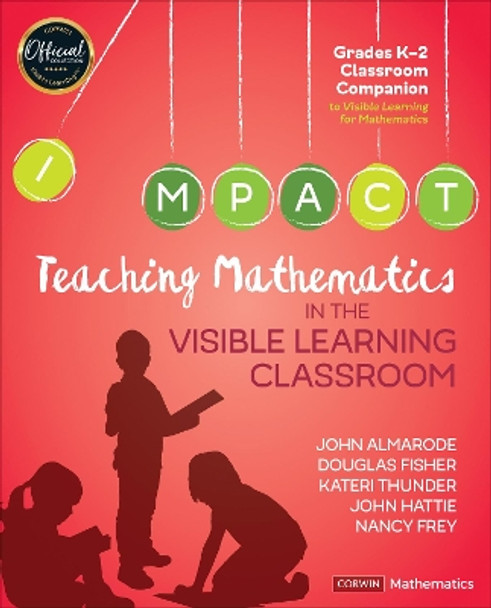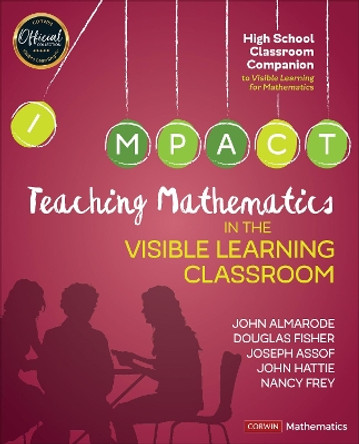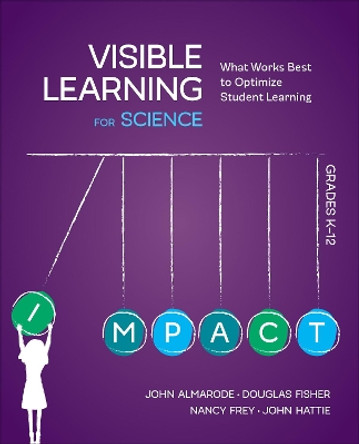Description
Select the right task, at the right time, for the right phase of learning
Young students come to elementary classrooms with different background knowledge, levels of readiness, and learning needs. What works best to help K-2 students develop the tools to become visible learners in mathematics? What works best for K-=-2 mathematics learning at the surface, deep, and transfer levels?
In this sequel to the megawatt bestseller Visible Learning for Mathematics, John Almarode, Douglas Fisher, Kateri Thunder, John Hattie, and Nancy Frey help you answer those questions by showing how Visible Learning strategies look in action in K-2 mathematics classrooms. Walk in the shoes of teachers as they mix and match the strategies, tasks, and assessments seminal to making conceptual understanding, procedural knowledge, and the application of mathematical concepts and thinking skills visible to young students as well as to you.
Using grade-leveled examples and a decision-making matrix, you'll learn to
- Articulate clear learning intentions and success criteria at surface, deep, and transfer levels
- Employ evidence to guide students along the path of becoming metacognitive and self-directed mathematics achievers
- Use formative assessments to track what students understand, what they don't, and why
- Select the right task for the conceptual, procedural, or application emphasis you want, ensuring the task is for the right phase of learning
- Adjust the difficulty and complexity of any task to meet the needs of all learners
It's not only what works, but when. Exemplary lessons, video clips, and online resources help you leverage the most effective teaching practices at the most effective time to meet the surface, deep, and transfer learning needs of every K-2 student.
About the Author
Dr. John Almarode is a bestselling author and an Associate Professor of Education at James Madison University. He was awarded the inaugural Sarah Miller Luck Endowed Professorship in 2015 and received an Outstanding Faculty Award from the State Council for Higher Education in Virginia in 2021. Before his academic career, John started as a mathematics and science teacher in Augusta County, Virginia. As an author, John has written multiple educational books focusing on science and mathematics, and he has co-created a new framework for developing, implementing, and sustaining professional learning communities called PLC+. Dr. Almarode's work has been presented to the US Congress, the Virginia Senate, and the US Department of Education. One of his recent projects includes developing the Distance Learning Playbook for College and University Instruction in response to the COVID-19 pandemic.Continuing his collaborative work with colleagues on what works best in teaching and learning, How Tutoring Works, Visible Learning in Early Childhood, and How Learning Works, all with Corwin Press, were released in 2021. Douglas Fisher is professor and chair of educational leadership at San Diego State University and a leader at Health Sciences High and Middle College. Previously, Doug was an early intervention teacher and elementary school educator. He is a credentialed teacher and leader in California. In 2022, he was inducted into the Reading Hall of Fame by the Literacy Research Association. He has published widely on literacy, quality instruction, and assessment, as well as books such as Welcome to Teaching, PLC+, Teaching Students to Drive their Learning, and Student Assessment: Better Evidence, Better Decisions, Better Learning. Kateri Thunder, Ph.D., has the pleasure of collaborating with learners and educators from school divisions and early learning centers around the world to translate research into practice. She has served as an inclusive early childhood educator, an Upward Bound educator, a mathematics specialist, an assistant professor of mathematics education at James Madison University, and Site Director for the Central Virginia Writing Project. Her research, writing, and presentations focus on equity and access in early childhood and mathematics education, as well as the intersection of literacy and mathematics for teaching and learning. Kateri has collaborated with thousands of educators to catalyze change in their classrooms, centers, and schools. She is the chair of NCTM's Research Committee and co-creator of The Math Diet. Additionally, she is a best-selling author for Corwin's Teaching Mathematics in the Visible Learning Classroom Series, the Success Criteria Playbook, and Visible Learning in Early Childhood. John Hattie, PhD, is an award-winning education researcher and best-selling author with nearly thirty years of experience examining what works best in student learning and achievement. His research, better known as Visible Learning, is a culmination of nearly thirty years synthesizing more than 2,100 meta-analyses comprising more than one hundred thousand studies involving over 300 million students around the world. He has presented and keynoted in over three hundred international conferences and has received numerous recognitions for his contributions to education. His notable publications include Visible Learning, Visible Learning for Teachers, Visible Learning and the Science of How We Learn; Visible Learning for Mathematics, Grades K-12; and 10 Mindframes for Visible Learning. Nancy Frey is professor of educational leadership at San Diego State University and a leader at Health Sciences High and Middle College. Previously, Nancy was a teacher, academic coach, and central office resource coordinator in Florida. She is a credentialed special educator, reading specialist, and administrator in California. She is a member of the International Literacy Association's Literacy Research Panel. She has published widely on literacy, quality instruction, and assessment, as well as books such as The Artificial Intelligences Playbook, How Scaffolding Works, How Teams Work, and The Vocabulary Playbook.
Book Information
ISBN 9781544333298
Author John T. Almarode
Format Paperback
Page Count 288
Imprint Corwin Press Inc
Publisher SAGE Publications Inc
Weight(grams) 520g







